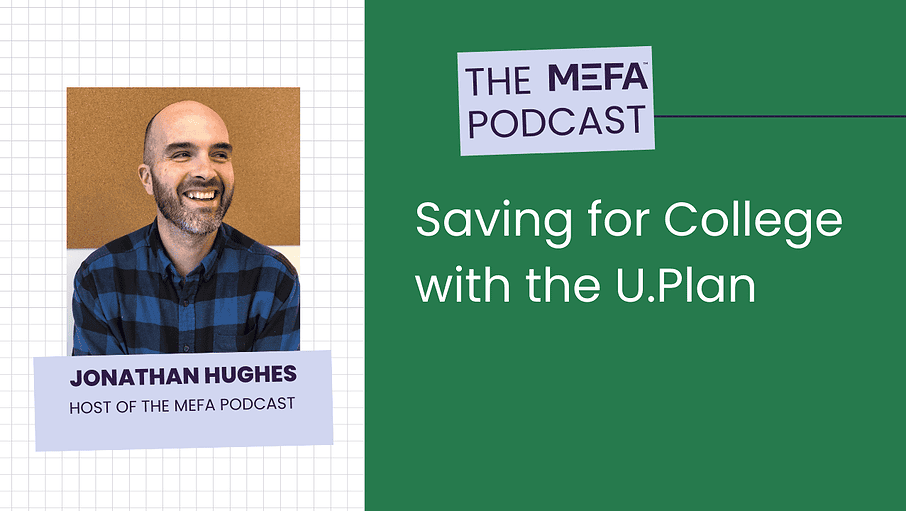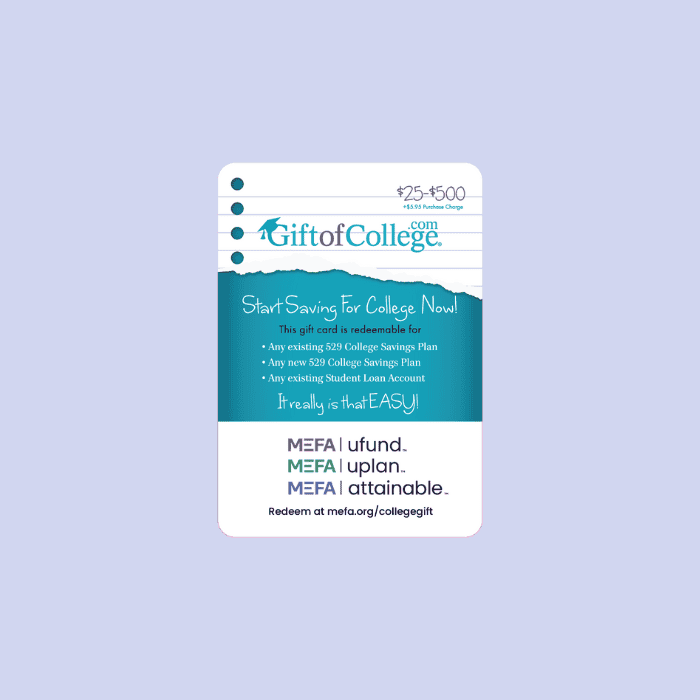

Resources Mentioned in this Episode
Jonathan Hughes: Hi, everybody. Thanks for joining us. Welcome to Navigating the Course to College, MEFA’s podcast. My name is Jonathan Hughes and I’m the assistant director of college planning and education. As always, with me is Jonathan Sparling.
Jonathan Sparling: Hi everyone. Associate director of college planning and education at MEFA.
Jonathan Hughes: Nice title! Well on today’s show, which is all about the U.Plan, we’ll be talking to a U.Plan customer and she can tell us all how she saved and used her U.Plan. And the reason that we’re talking about the U.Plan today is because the U.Plan enrollment period ends July 15th. And we’ll talk more about what that means in the U.Plan segment.
We’ll answer some questions from the mailbag, of course, but first as always, we’re going to have some news as you. As we know, lots of news coming out these days about what everyone’s doing for the fall. And so Jonathan, what’s been going on?
Jonathan Sparling: As we record this right now, today is July 2nd. And so with the start of July, traditionally, a lot of colleges will send bills for the upcoming fall semester.
And so we are seeing that same timeline this year, despite everything that has happened. Colleges by and large are sticking to sending out the bills this time of the year. And so, because of that, obviously before bills go out, colleges needed to make decisions about what the fall semester was going to look like, where they’re going to be.
Fully on campus or they’re going to be fully remote or were they going to be some type of hybrid? And so just in the past couple of days, we have seen a lot of colleges, both locally and nationally come out with concrete plans of what they are planning to do. By and large, uh, the trend that we’re seeing is colleges are planning to have students on campus if they can.
While following strict social distancing guidelines, uh, implementation of testing, um, they are, uh, thinking about ways to socially distance in classrooms. Residence halls are, are going to be reworked. Um, so schools are, are planning to do that by and large, uh, with the understanding that not only will social distancing be in place, but also testing.
And so, um, just yesterday, for example, Worcester Polytech Institute indicated that they will be welcoming students back to campus, but that there will be strict testing involved. Every student will be tested along with faculty and staff and, um, that won’t just be a one time effort. It will be multiple times now.
What’s interesting is the schools that are mentioning, the students will come back, primarily be on campus. They are leaving the option on the table for students to attend class virtually again, most are that are saying, we’ll welcome you back to campus. You can come here. There’s going to be some social distancing, some testing, but if you do not feel comfortable going into class, we’re going to have a way for you to view those lectures virtually or still take part in the, um, the classroom participation.
So we are seeing, you know, a lot of colleges say that, um, the hybrid model, we are seeing some mentioned that they are going to, um, err on the side of, of doing most classes, virtually. UMass for instance, UMass Amherst announced on Monday of this week, I believe that they are planning to do almost all classes virtually, but what’s interesting about their decisions, they also mentioned that students will be welcomed back on campus if they would like to live in the residence halls. But again, they will have to adhere by social distancing guidelines.
So to say it mildly, it’s a mixed bag, for sure.
Jonathan Hughes: I wonder if they current spike and the covet numbers in different parts of the country will affect those plans at all. We’ll see, I suppose.
Jonathan Sparling: Yeah, absolutely. I think it’s something to keep an eye on and, um, you know, colleges will keep an eye on and continue to monitor that situation.
Jonathan Hughes: Yeah. So what else is going on? Something about new loan rates, is that right?
Jonathan Sparling: Yes, new loan rates. I have the, uh, the MEFA shirt on today. I’ll show you here.
Jonathan Hughes: Ah, nice. Now I don’t have one of those. How do you have one of those shirts?
Jonathan Sparling: Well, now it’s strange that you don’t have one, how long have you been here?
Jonathan Hughes: Uh, Hmm. Let’s see. Since George, George W. Bush was president when I was, uh, I mean, it was like early days of George W. Bush.
Um, No. I mean, maybe I did and it’s, it’s, it’s, you know, gone to history now, but
Jonathan Sparling: That’s crazy. So I’ve only been here two years and I have one, so I don’t, I don’t know.
I’m just, I was just getting so, so no, we, so we kept the shirts as part of a national conference that we went to. So that’s,
Jonathan Hughes: I’m sure that’s okay.
Jonathan Sparling: When this pot episode goes, Nat, you know, National and, and folks hear about it though, like, well, we’re going to get Jonathan a shirt. So, um, that’s, that’s where we got it from. But anyways, yeah. So new, uh, new rates were announced, um, at MEFA, for the, uh, for the upcoming lending season. Uh, very happy to announce that this year, um, rates are lower than they were last year.
Um, and so on the immediate repay 10 year, the low. And of the, of the interest rate was 3.95. This year, it’s going to be 3.7, 5%, which is great. Um, and what’s really great is not only is that that lower, low, but the, um, uh, bands have been condensed. And so, um, last year, of course, we only do fixed rates, interest rate loans, but when folks were approved for a loan, they would, um, Depending on the repayment plan, the rates were anywhere from a 3.95 up until I think like a seven point, uh, 7.3. 7.4
The upcoming year, again, it’s that low of 3.75. But the high on the interest rate that you would be subject to is a 5.5% depending on the type of repayment plan. So. Really great options for families, you know, for folks that do need to borrow, you know, certainly as we always say, you’re maximizing free money. First you’re paying what you can out of pocket.
You’re paying with those 529. So these are your U.Plans, U.Funds. Um, and you know, you’re borrowing the federal loans first, but if you do need to borrow, you know, certainly it’s great that we’re able to offer some really great rates to students and families, um, at really competitive, uh, competitive prices.
So go to mefa.org, if this is something that you do need to research, and if this is something you are considering, you’ll see our new loan rates. And, um, if you are considering a loan, definitely check out the loan calculator that we have, which does a really great job breaking down what your payments would look like.
So good news on the rates for sure.
Jonathan Hughes: Yeah, well said, thank you. And then one final item of news. Here’s some news on the SAT®, standardized tests, the SAT and ACT.
Jonathan Sparling: We’re seeing more and more schools announced that they will either be test optional or not considering SATs or ACT scores for the upcoming class of 2021. We’ve been noticing this trend for awhile. Um, there are a lot of schools that have, um, gone test optional and, um, certainly the, the coronavirus pandemic has kind of re-shifted priorities. And, and we know that many students aren’t able to get to a testing center. Um, we know that tests themselves aren’t being offered as often as they had in the past.
And so more and more schools are moving in this direction of going test optional, whether those schools that have done this temporarily because of the coronavirus stay is, is yet to be seen. I, you know, I would imagine that some will go back, you know, once things are, we’re able to be in person and, and, you know, tests are being offered more frequently. Some schools may go back and make that a larger part of their, um, admission criteria. But I would venture to guess that some that are doing a temporarily we’ll make it a, um, a permanent change.
Jonathan Hughes: Good to know. All right, well that about does it for the news.
And I think what we’re going to do now is go ahead to our next segment, which is to open up the mailbag and go over some questions that we’ve been receiving either through emails, through one on one conversations that we’ve had with folks, uh, from phone calls. So our first question comes from Riz. And Riz writes, uh, I would like your assistance in researching scholarships. Can you recommend websites or other resources?
So it’s a bit of a softball admittedly, but I think it’s a good opportunity to talk about some ways that people can research scholarships. And one of the, well, the first thing that I always say about scholarships, and I’m typically talking to high school seniors or high school students, I’ll say we recommend a two track approach.
Uh, that is, uh, when looking for scholarships for local scholarships, talk with your high school guidance counselor, they have the best resources on local businesses and organizations offering scholarships. For national scholarships there are a number of, uh, scholarship search engines that you could visit.
Uh, and we’re always careful to say that you should never pay to have a scholarship search done. So we recommend some websites, some search engines on our site, chief among them, probably mefapathway.org, which is our college and career portal, where students can go and search scholarships and you can start searching for scholarships as early as your freshman year of high school.
So I think that people don’t always realize that that’s the truth. Uh, we also mentioned some other sites, uh, fastweb.com, goodcall.com. Um, and one final piece of news is that if you follow us on social, follow us on Facebook, follow us on Twitter. We’re constantly being notified from organizations that offer scholarships about their scholarships and want our help in promoting them. And we’re always doing that sort of posting about scholarships that are available for folks to apply to. So, um, hopefully that answers the question. Do you have any other, um, tidbits to add to that Jonathan?
Jonathan Sparling: Yeah, I think that’s great. Just two other things.
I’m thinking one is an additional site goingmerry.com another, uh, scholarship search engine to, to just look at, and then in terms of kind of like general tips, um, you know, the one thing, the one tip I always give to students is, you know, when you’re searching for scholarships, right? Remember that if you see one for like $5,000, $10,000, $15,000, so does everyone else.
Right. And so there’s probably going to be a lot of applicants for the high dollar ones. So not saying don’t apply for those, but just to remember that, you know, some of the smaller ones that $250 to $500, the $750 can add up quickly as well. And so, you know, don’t ignore those completely.
You know, I’ll never forget when I worked in financial aid at WPI, I would consistently see students come in with multiple outside scholarships. And, and this one student, I remember we had it, it was very paper, so folks would write down their outside scholarships. And one student came in and it was, you know, I believe she had over 20 outside scholarships.
I’ll never forget because she ran out of space and on the sheet, over 20 scholarships, and none of them were higher than $2000, you know, $500 a year to $750 $1,000. And so, you know, certainly she spent a lot of time doing that. I’m not suggesting it won’t take time, but just being aware that those smaller ones can add up as well.
Jonathan Hughes: Great. Now, our next question comes from Darcy and she writes, this one will be, this one I think is going to be for you Jonathan. Now that we have more clarity about the fall semester and my daughter has all classes being online. So I guess that’s what’s happening at her daughter’s college. We have determined she will not be living on campus, which costs substantially, since we don’t know what the spring semester will look like. Can or should we hold out on taking a Parent PLUS loan to assist with paying for that semester? If the college does not return to campus in the spring, we will likely not need alone for this year.
Jonathan Sparling: So what I would say in that situation where there’s some uncertainty in the spring, You can borrow, you can take out a loan at any point throughout the academic year.
So for this family, you know, if you feel comfortable knowing that you could essentially cover costs for the fall semester, um, from savings or out of pocket or with scholarship, and you’re, you’re essentially only borrowing for room and board costs, which you wouldn’t have for the first semester, because she’ll be living at home, then certainly you can wait to take out that loan. Um, if you still need to borrow for some funds for the fall, but you don’t know how much to borrow for the whole year, because if they get back on campus in the spring, then the, the funds could look very different or your expenses could look very different than the fall.
Um, you really have two options. You could, you could assume what the, or you could estimate what the cost would be for the, for the spring, with them back on campus and basically borrow that amount. And then if they end up being virtual for the spring as well, you could just reduce the loan or you could borrow a loan just for the fall.
Okay. You know, whatever it is, whatever you had to borrow, and then you could borrow another loan for the spring. And the spring loan could either cover, again, just the virtual experience, or if the room and board expense comes back, then you could borrow to cover that as well. So, you know, kind of a couple different options that families have, but I think the takeaway is that you can borrow at any point throughout the year, and you can also reduce the amount that you need to borrow any point throughout the year.
Jonathan Hughes: That’s great. Thank you very much. Our last question has to do with the U.Plan. And so it’s a bit of a technical question, but it does lead us into the U.Plan topic. And that is a, it comes from Brian and he writes, hi, I started contributing to the U.Plan in 2019. How do I view the percentage of tuition credit my account is entitled to based on my contribution.
So, um, to answer that question, I kind of had to talk about the U.Plan a little bit and the way that the U.Plan works. It’s a prepaid tuition program. So it’s different than a 529. It’s a savings vehicle, but it’s different.
It’s not invested in the market. Um, and you know, it’s not for, you know, pull out the funds and, and the earnings and use them for any qualified educational expense. The way it works is you would put funds in throughout the year and at the end of the year, so to speak, which is coming up July 15th, we take all the money that you have in your account.
And we put that towards a bond. And so the only thing that you have to do is tell us what year or years you want that bond to mature in. And you want to pick one or more of the years that the child is going to be in college for. So. Depending on how much money is in your account at the time that we purchased those bonds, whatever amount that is, that’s going to correspond to a percentage of tuition, this year’s tuition at each participating college or university in Massachusetts.
So what that means is if you have a thousand dollars in maturity or 2030, that’s going to buy 10% of tuition at a college that costs. $10,000 this year. And when that child goes to that college in 2030, you’ll have 10% of 2030s tuition. So you’re locking in the percentage of tuition that you’ve purchased and you can do this, you know, on a yearly basis. The next year would be the next year’s tuition percentage. And if you’re stacking on maturity, you know, money on, in the same maturity or you’re adding to your percentage.
So to answer your question, You can go on and set up online access to your account and view all sorts of information. How much money you have, um, how much interest is accrued on that? Um, you know, you can set up an automatic withdrawal from your checking account and you can go and have access to your statements.
So what you’d want to do is go to your document section. Get a look at your annual statement because the percentages reflect on purchase. The bond purchase happens every year. So your percentages aren’t finalized until after the bond purchase once a year. So you can go to your annual statement, pull that down and see what percentage you have purchased at each participate in college and university.
So. That was a lot of information and this sort of gets us to our next topic. But before I do that, I want to say, if you have any questions, you can email them to [email protected]. We need questions for the mailbag. Of course. Uh, you can also call us at 1-800-449-6332. Uh, but if you have questions again, to email to us, the address is [email protected].
Now, we’re going to close up the mail bag and head on to our sort of main topic of discussion today, which again is the U.Plan. Now I can explain to you, how the U.Plan works. I just did explain to you sort of how the U.Plan works, but we always find it, it seems to be the case, particularly with the U.Plan that the most effective spokespersons spokespeople spokespersons for the program, either one, um, are the current customers, are the customers who have saved in the plan and benefited in the plan.
Um, so towards that end, um, we thought it would benefit if you heard from somebody who did save and who did benefit from the U.Plan. Um, I spoke with her this afternoon. She is a mom of two recent Massachusetts college graduates. So congratulations to her on that. And she used the U.Plan, uh, to pay for a portion of those costs. So now let’s hear my conversation with Sue Metcalf.
Welcome to the podcast, Sue Metcalf. Thank you. Um, sure, sure. I, I, again, I, one of the things I said before to introduce you was that you are a mother of two recent college graduates, right?
Sue Metcalf: I’m actually, just one, I have a rising junior.
Jonathan Hughes: Oh, I’m sorry. Okay. Well, congratulations on the graduate. Congratulations on the rising junior as well. Um, and, and you’ve done, um, a couple of things to save, which is great. I mean, one of the things that we’re always trying to get in people’s heads is how important it is to save. And if you could just talk a little bit about um, what you did to save, I know you did a 529 as well as, as a U.Plan, but if you could talk about what specifically about the U.Plan, uh, appealed to you. Sure.
Sue Metcalf: Um, with that we had actually, yeah, we had started the 529 before the U.Plan and, but we really hadn’t put much money in, this was back in like 2011.
So 2011, 2012, and we thought we need to get going because our daughter would be graduating in 2019 from college. So we thought, oh yeah, we got to go. So my husband had heard about the U.Plan. He just thought it, he really liked the idea. And, and so did I and the fact that, uh, this was a plan that you could pay early and, um, and that money was safeguarded in regards to rising tuition years ahead.
So that’s, that’s what we really liked about it.
Jonathan Hughes: Right. So, so it’s the only program really that you can use to sort of freeze the cost of college in a sense, because as tuition goes up, so does your value of your percentage. Yeah. And you had mentioned too, that you had, um, and I should mention that you wrote a blog for us on this too, and we can attach it to the, uh, to the show notes.
I might, I thought it was a fantastic blog, a fantastic piece of writing. Um, and you talked on that a little bit about the hesitance hesitancy you had, which I think is very common for people who are comparing plans that U.Plan in the, in the, U.Fund 529 Plan because the U.Plan, uh, locks in tuition and fees at a participant at a list of participating in colleges.
So people get nervous about what happens if you know, my child doesn’t end up going to one of those colleges
Sue Metcalf: And, and that’s, that was what I was hesitating about. My husband was like, yeah, let’s go for it. And I was like, yeah, let’s just wait. I mean, let’s just think about this little bit. Um, and so two things, one is that I looked at the list of the schools and there is such a wide variety of schools there.
Fabulous. So you’re not stuck in one type of college or university. Um, and the other thing that probably even more importantly, is that I realized that, um, let’s say one of my kids decided to go out of state. Um, we would get that money back and not only would we get the money back, we’d get interest back.
So I mean that we weren’t losing anything really.
Jonathan Hughes: That’s correct. Yeah. Yeah. So, and I think some people do get worried about that. Um, and other option that exists is, you know, if you, as you, do you have kids that overlapped in college, so you had two in college at the same time. Um, you can transfer accounts over from one beneficiary to another.
So if your older child, for example, didn’t go to participate in college, but the younger one did, you could transfer those certificates over and still retain the value of that. Um, so when it came time to, to use the U.Plan, um, you know, not wanting to go into numbers or anything like that, um, did you found that, that it was, It worked out well for you?
Sue Metcalf: It did. Um, the, the, kind of the, the exciting part of the story is that without any pressure from us, because I really didn’t want to pressure the kids. I wanted them to have that choice of going out of state on their own. They just both decided to go to Massachusetts schools.
One of them had a small four-year private school and the other one, a big, large state university. So, yay. You know, that’s cool. You all are fabulous. You’re easy to talk to knowledgeable accessible all those things. And also now with the new website, everything’s even more accessible. Um, so it’s been, it’s worked out extremely well for us and we’re still doing it four years ago.
Jonathan Hughes: You got two more years ago, let’s say. Yeah, that’s great. So hopefully, you know, it’ll continue to be as easy and I’m sure. Well, you also mentioned something really great in your blog, which is the benefits of using both the five 29 and. Uh, the new plan. And I do think people sometimes think they can only do one or the other, but you can actually do both.
And there’s, there’s some good reasons for doing both. And I’m wondering if you could, you could tell us how you’ve managed it.
Sue Metcalf: Since 2012, we’ve been putting some money into the 529, a little bit at a time. And with the U.Plan that was all set. Um, and then when it came to pay, the 529 pays for, let me go back.
The, the U.Plan pays for tuition and fees, whereas the 529 pays for room and board and things like books, extra costs like that. So it’s, so the bill, which is the bill paying process and for the colleges, isn’t that difficult. It’s just it’s we’re getting money from one place for one thing and one place for another one account for another.
Jonathan Hughes: Yeah. Yeah. And when it comes time to, uh, to actually interact with, uh, by phone or what, have you found that to be easy?
Sue Metcalf: Yeah, definitely. I, um, As I was saying, you all are very easy to get in touch with. And that was pre, I know that there’s a, there is a website now for the U.Plan, which is relatively new. Right. Um, then that, that makes things even more accessible. I can pull up the account and take a look at it anytime at my own leisure. Um, and I haven’t. Actually asked for payment through the website yet, but I will next month. So, yeah.
Jonathan Hughes: And I guess just to wrap up a bit, is this something that you would recommend or have recommended that anyone take a look at possibly using the plan?
Sue Metcalf: Yeah, definitely. I’ve been very happy with, with me, for you all. I don’t know, like I said, this is the third time. This is very helpful. I mean, I don’t feel like I’m, I have to go through a lot of hoops to just talk to a real person. I think that’s a big deal. Yeah.
Jonathan Hughes: Well, thank you so much. Congratulations on using the U.Plan and the success of your kids in college and the success of having them stay close to home too.
Sue Metcalf: Yeah. That that’s an added bonus. Something that I didn’t really think about early on, but it’s nice to be able to, you know, have lunch with them once in a while. That’s good. Yeah.
Jonathan Hughes: Well, thank you so much again, have a good weekend and hopefully everything continues to go well for you.
Sue Metcalf: Okay. Great.
Jonathan Hughes: Thanks.
Sue Metcalf: Thank you.
Jonathan Hughes: All right. Well, we hope you enjoy that, everybody. I just wanted to remind you once again, that the deadline for investing in the U.Plan for this year is July 15. For if you wanted to do that, please call us a 1-800-449-6332 or visit mefa.org. Click on the start saving tab and then click into U.Plan.
You can contribute in a check. You can contribute, um, through the website as well. After July 15th, you won’t be able to contribute for this year, but if you wanted to contribute for the next year as bond purchase, which is the 2021 bond purchase. You’ll be able to do that in the beginning of August. So there’ll be a blackout period.
Um, so we can purchase the bonds and then next year’s enrollment will be open beginning of August. Now, if you have any questions on the U.Plan or anything else, college related, please call us once again, 1-800-449-6332 or email us at [email protected]. Connect with us on social, like us on Facebook. Follow us on Twitter at me for tweets. Visit us on LinkedIn, please visit mefa.org to see our current slate of webinars that we’ll be offering. And of course, please like, or subscribe to the podcast. So you can do that on Spotify, Apple, iHeartRadio, wherever you get your podcasts. Other than that, that’s it for me, Jonathan.
Jonathan Sparling: Great, good show. And, um, yeah, we’ll, we’ll do it again soon. Thanks everyone. Thanks for listening.












